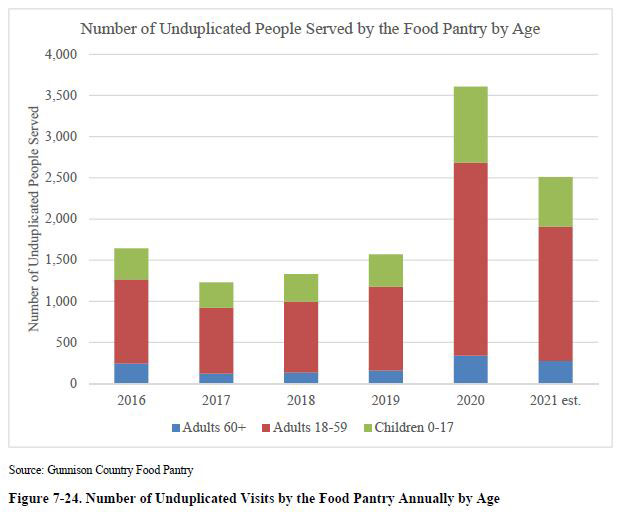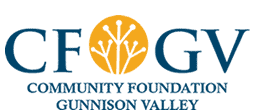State of the Community 2022
Since its founding as part of the One Valley Prosperity Project, CFGV has been a member of the Gunnison County Community Health Coalition. Formed to address the major challenges our community faces with regards to community health and equity, we have been working with other key community partners (including representatives from the County Department of Health and Human Services, the GVH Foundation, Juvenile Services, Adult Protective Services, and Gunnison Valley Family Physicians) to improve collaboration in addressing basic needs for community members.
Recently, the Community Health Coalition commissioned a broad study called the State of the Community 2022 Report: Behavioral Health Needs and Gaps Analysis for Gunnison County that sifted through existing data sources such as the US Census and other publicly available data as well as interviews with impacted community members to conduct a comprehensive assessment of behavioral health in our community.
To be frank, we view the report produced by this group as an urgent, loud, and immediate alarm bell that we need to come together, and quickly, to both tackle immediate needs and long-term challenges.
On March 10, the researchers presented their findings at a community meeting and later shared the executive summary (31 pages) and full report (283 pages) with meeting participants. While we plan to share more of the information they gathered and presented over time, we wanted to take some time this month to share some of the findings that most resonated with us.
What is Behavioral Health?
Part of the challenge with tackling behavioral health problems in a community is that a lot of people don’t have a good grasp of what behavioral health actually means. The researchers who worked on this report synthesized several definitions from other sources to define behavioral health as:
- “How environmental factors (e.g. housing and food security, jobs, childcare, access to and coordination of health services, home life, social isolation) contribute to mental and physical health outcomes.”
- In addition, “behavioral health means building a community that supports and promotes healthy behaviors while providing opportunities for individuals, families, and the community to access and provide necessary services that perpetuate wellness.”
One point made frequently throughout the report is that many of our systems in place to address behavioral health target symptoms rather than underlying causes. We have created reactionary systems to respond to the immediate need of an individual presenting in the emergency department at Gunnison Valley Health with an overdose, for example, but haven’t addressed the underlying environmental factors, such as lack of housing and the financial and other stress individuals are carrying that contributes to them abusing substances.
The report looks at data from a plethora of sources that illuminates both symptoms of behavioral health and the contributing factors that influence our behavioral health as a community. This is certainly not a comprehensive overview of the report. We recognize that many of you will not have time to read the full report, or even the executive summary, and commit to continuing to communicate the findings with you in digestible chunks over the next several months. In addition, our staff is always available to discuss the findings and possible community collaborations to support the health of our community.
Findings Related to Behavioral Health Contributing Factors
Based on our survey results from last fall, we know that many of you are aware that housing affordability is a major issue facing our community. Over the last few months, we’ve seen many articles covering the challenges that people across many income levels face in securing safe, affordable housing. The numbers may be even more alarming than many people are aware of.
The writers of the State of the Community 2022 Report referenced a 2016 study comparing Taos County to Gunnison County and several other rural counties with tourism-based economies. They found that in Gunnison County, 42% of people have a mortgage cost greater than 30% of household income. The most recent US Census showed that half of renters pay greater than 30% of their income in rent. This points to an immediate need for more affordable housing, as many community members and their families are forced to make trade-offs (like foregoing health insurance and doctor visits or skipping meals) to be able to afford to pay the high cost of housing.

Food security is another major issue. During the beginning stages of the pandemic, the number of community members seeking assistance from the Food Pantry dramatically increased. While that number has dropped since the peak in early/mid-2020, it still remains well above pre-pandemic levels. We hope that some of that is in part due to the Food Pantry and other local organizations doing more to actively seek out people who are in need of food. The number of people in our community who are estimated to be food insecure is about 15%. That equates to 2,520 of our community members who need help meeting a core basic need.

Those who have been engaged with the work done by the One Valley Prosperity Project over the last several years may already be familiar with the concept of the self-sufficiency standard vs. the federal poverty line.
Briefly, the federal poverty line is based on one factor: the cost of food. The cost of a “minimum food” diet in 1962 was tripled and has been adjusted for inflation over the years. Those whose incomes fall below the calculated amount based on family size are considered to be living in poverty and have access to government services. In 2022, a family of four is considered to be living in poverty with an annual income under $27,750. This calculation sorely underestimates the number of people actually experiencing poverty. While we all know that food costs are going up quickly right now, we also know that other costs are also going up dramatically. The University of Washington’s Center for Women’s Welfare developed an alternative measure, called the Self-Sufficiency Standard that looks at the actual costs, based on family size/composition and geographic differences in costs, to afford basic needs. In 2019, 13 percent of Gunnison County residents lived below the federal poverty line. On top of that, this State of the Community 2022 Report estimates that an additional 17-31 percent of community members live below the self-sufficiency standard. That translates to a total of up to 44% of our community members who have to make trade-offs or seek public or private assistance in order to make ends meet.

These statistics are concerning on their own. However, the immediate and long-term consequences of this state of affairs is also concerning. We recently adopted a new vision statement at CFGV as part of our new strategic plan:
CFGV inspires and connects people so everyone can thrive.
One of our board members, at a recent meeting, described thriving as having the ability to put down roots in a place and build a foundation for the future. This opportunity to thrive is out of reach for many in our community at the moment.
Symptoms of Poor Behavioral Health
The stressors faced by members of our community translate to real impacts on our County’s healthcare system, already under stress due to the COVID-19 Pandemic. Other nonprofits that serve community members in crisis are also seeing an increased demand for their services.
In spite of Gunnison Valley Health adding a new Behavioral Health Mobile Crisis Unit in 2021 that served quite a few people outside of the Emergency Department, we are seeing a dramatic increase in the number of behavioral health-related admissions to the Emergency Department. This could be, in part, due to greater awareness and more people seeking assistance. It’s also likely related to the increasing stress community members face two years into a global pandemic.

Likewise, the number of people served by Project Hope is going up dramatically. With housing costs going up, escaping domestic violence becomes even more challenging.

These two examples are just a couple of the poor behavioral health outcomes the researchers found in the Gunnison Valley.
What Can We Do?
The numbers are large and the trends are alarming, in many cases. The full State of the Community 2022 Report outlines exactly how steep of a mountain we have before us that we need to climb. It will not be easy, but the health of our community depends on systematically and collaboratively tackling the factors that are contributing to our community’s poor behavioral health. We can and will collaborate across the nonprofit sector and partner with the local government and business community to develop solutions to these challenges.
Over the next several months, we’ll be sharing more from this report. We invite you to reach out to our team or give us a call at 970-641-8837 if you have any questions or would like to be involved in this effort. We hope you’ll join us.
You can access the full report here and the executive summary here.
(All figures/charts reproduced from full report.)
